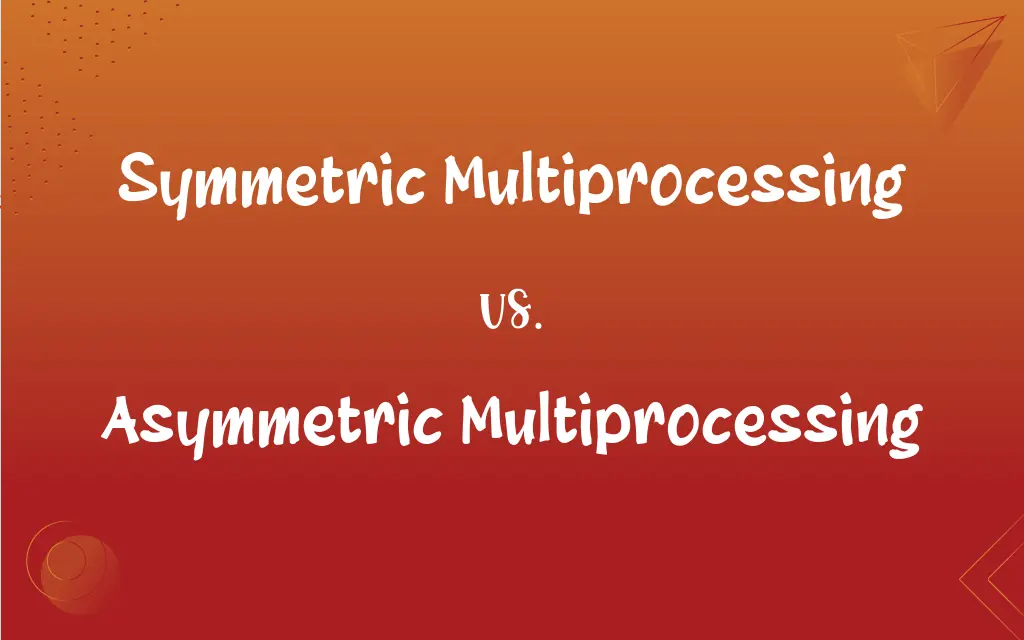Symmetric Multiprocessing vs. Asymmetric Multiprocessing: What's the Difference?
Edited by Janet White || By Harlon Moss || Updated on October 16, 2023
Symmetric multiprocessing (SMP) involves multiple processors sharing a single OS and memory, equally handling tasks. Asymmetric multiprocessing (AMP) designates specific tasks to specific processors.

Key Differences
Symmetric multiprocessing (SMP) is a type of parallel processing architecture where multiple processors share the same memory and run the same OS. In this system, all processors are treated as equals, and each processor can execute any task in the system. Asymmetric multiprocessing (AMP), on the other hand, allocates specific tasks to specific processors. In AMP, not all processors are considered equal, and tasks are distributed based on the role assigned to each processor.
In symmetric multiprocessing, processors can handle any task, providing a balanced and versatile system for executing multiple tasks simultaneously. The operating system is responsible for managing the processors, ensuring efficient distribution and execution of tasks. Asymmetric multiprocessing, conversely, often dedicates particular processors to specific functions, like managing I/O operations. This means there's a division of labor, where certain processors are specialized for specific tasks.
Symmetric multiprocessing often provides better load balancing since all the processors can take on any task, leading to optimal utilization of resources. This ensures that no single processor is overloaded while others are idle. Asymmetric multiprocessing, in its dedicated approach, might not always achieve this balance. Some processors in an AMP system might be underutilized if their specific task isn't frequently demanded.
An advantage of symmetric multiprocessing is its simplicity in terms of software design. Since all processors are equal, the OS doesn't need to differentiate between them. However, in asymmetric multiprocessing, the software must be designed to recognize the different roles of processors and allocate tasks accordingly. This can lead to a more complex software design and management process.
In some scenarios, asymmetric multiprocessing might be preferred over symmetric multiprocessing. Systems that require specialized processing for certain tasks, like real-time processing or specific I/O operations, can benefit from AMP. Meanwhile, SMP is generally preferred in scenarios where workload is unpredictable, and an even distribution of tasks across all processors is desired.
ADVERTISEMENT
Comparison Chart
Processor Equality
All processors are treated as equals.
Processors have designated roles.
Task Allocation
Any processor can handle any task.
Specific tasks are assigned to specific processors.
Software Complexity
Simpler software design; all processors are managed equally.
More complex design due to processor role differentiation.
Load Balancing
Offers better load balancing.
Might have imbalance due to task-specific processors.
Use Case
Preferred for unpredictable workloads.
Useful when specialized processing is needed.
ADVERTISEMENT
Symmetric Multiprocessing and Asymmetric Multiprocessing Definitions
Symmetric Multiprocessing
Symmetric multiprocessing achieves optimal load balancing due to its equal treatment of processors.
With symmetric multiprocessing, no single processor gets overloaded while others remain idle.
Asymmetric Multiprocessing
Asymmetric multiprocessing assigns specific tasks to designated processors within a system.
In asymmetric multiprocessing systems, a processor might be exclusively assigned to handle I/O operations.
Symmetric Multiprocessing
Symmetric multiprocessing is a parallel processing system where all processors share a single memory and OS.
In symmetric multiprocessing setups, each processor can handle tasks from a common queue.
Asymmetric Multiprocessing
Asymmetric multiprocessing requires a more intricate software design to manage the roles of different processors.
The OS in asymmetric multiprocessing needs to recognize and allocate tasks to processors based on their defined roles.
Symmetric Multiprocessing
Symmetric multiprocessing is versatile, ideal for scenarios with unpredictable workloads.
Data centers with fluctuating demands often use symmetric multiprocessing to ensure balanced task distribution.
Asymmetric Multiprocessing
Asymmetric multiprocessing doesn't treat all processors equally, leading to specialized roles.
Asymmetric multiprocessing can have one processor managing real-time processing while another handles database queries.
Symmetric Multiprocessing
Symmetric multiprocessing treats every processor as equal in terms of task allocation and execution.
Symmetric multiprocessing doesn't prioritize one processor over another for particular tasks.
Asymmetric Multiprocessing
Asymmetric multiprocessing might have imbalanced workloads due to its task-specific nature.
In asymmetric multiprocessing setups, some processors might be underutilized if their assigned tasks are infrequent.
Symmetric Multiprocessing
Symmetric multiprocessing simplifies software design since all processors operate under the same OS and memory.
Developers often prefer symmetric multiprocessing for its straightforward design and management.
Asymmetric Multiprocessing
Asymmetric multiprocessing is beneficial for systems that demand specialized processing for certain operations.
High-performance gaming systems might use asymmetric multiprocessing to allocate specific tasks to specialized cores.
FAQs
Can any processor in SMP handle any task?
Yes, in symmetric multiprocessing, any processor can handle any task.
How is asymmetric multiprocessing different?
In asymmetric multiprocessing, specific tasks are assigned to designated processors, leading to specialized roles.
Are all processors treated equally in AMP?
No, in asymmetric multiprocessing, processors have designated roles and tasks.
Does symmetric multiprocessing ensure load balancing?
Yes, symmetric multiprocessing offers better load balancing by allowing any processor to handle any task.
Does SMP favor one processor over another?
No, symmetric multiprocessing treats all processors as equals.
Are tasks distributed based on processor roles in AMP?
Yes, in asymmetric multiprocessing, tasks are allocated based on the defined roles of processors.
Can AMP have underutilized processors?
Yes, in asymmetric multiprocessing, some processors might be underutilized if their specific tasks aren't frequently needed.
Is software design simpler in SMP or AMP?
Symmetric multiprocessing generally offers a simpler software design.
When might one choose AMP over SMP?
Asymmetric multiprocessing is beneficial when specialized processing for certain tasks is required.
Is AMP software design more complex?
Yes, asymmetric multiprocessing requires a more intricate software design due to processor role differentiation.
Which system is easier to manage?
Symmetric multiprocessing is generally easier to manage due to its even treatment of processors.
What is symmetric multiprocessing?
Symmetric multiprocessing is where all processors share a single memory and OS, treating every processor equally in task allocation.
Which system is more likely to have an imbalanced workload?
Asymmetric multiprocessing might exhibit imbalanced workloads due to its task-specific nature.
Which system is better for unpredictable workloads?
Symmetric multiprocessing is preferred for unpredictable workloads due to its balanced task distribution.
Which system offers more versatility?
Symmetric multiprocessing offers more versatility due to its balanced task allocation.
Is SMP efficient for systems with fluctuating demands?
Yes, symmetric multiprocessing is ideal for systems with unpredictable workloads due to its balanced distribution.
When is AMP more preferable over SMP?
Asymmetric multiprocessing is preferred when there's a need for specialized processing for specific tasks.
How does SMP manage its processors?
In symmetric multiprocessing, the OS manages all processors equally without prioritizing any.
What's a common use case for AMP?
Asymmetric multiprocessing is often used in systems requiring specialized processing, like real-time tasks.
Does AMP require task-specific processors?
Yes, asymmetric multiprocessing assigns specific tasks to designated processors based on their roles.
About Author
Written by
Harlon MossHarlon is a seasoned quality moderator and accomplished content writer for Difference Wiki. An alumnus of the prestigious University of California, he earned his degree in Computer Science. Leveraging his academic background, Harlon brings a meticulous and informed perspective to his work, ensuring content accuracy and excellence.
Edited by
Janet WhiteJanet White has been an esteemed writer and blogger for Difference Wiki. Holding a Master's degree in Science and Medical Journalism from the prestigious Boston University, she has consistently demonstrated her expertise and passion for her field. When she's not immersed in her work, Janet relishes her time exercising, delving into a good book, and cherishing moments with friends and family.































































